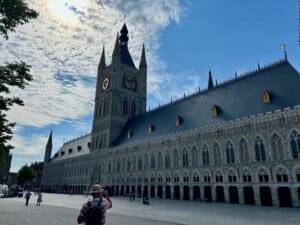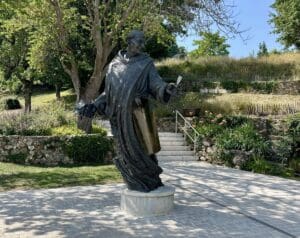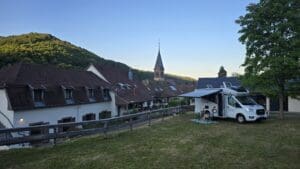This is the seventh part about our trip to India. Here you can find parts one, two, three, four, five, six and eight.
As we mentioned earlier, it was really nice to come to a slightly calmer city after Mumbai and Jaipur. The city has received its epithet, city of lakes, from the seven lakes that surround the city. Most of them have been created by dams and the original purpose was to facilitate water supply for the city and agriculture. It is perhaps not entirely inconceivable that the maharajas who built them also had other, more aesthetic purposes, but the official version is that it was for the sake of the people.
The lakes and all the greenery that comes with them make the place a bit of an oasis, especially compared to the western and northern parts of Rajasthan which are largely desert. In addition to the lakes, there are also many canals so that a large part of the city is next to water. Before we left, we read that Udaipur was known as the Venice of Asia but that was probably a European invention as none of the people we spoke to had heard of it.


The city is beautiful, especially in the evening, and there are a lot of temples, palaces, forts, parks, alleys, restaurants, shops, etc. Even though it is a popular tourist destination, they have still managed to keep what is genuine and unique from many other places which, as the growth progresses, become more like a smooth theme park.






One of the days our newfound artist friend took us on a city tour. It was nice that it wasn't so organized as it gave us the chance to see places that probably aren't on the tourist tour. I have to say though, buying chai from a guy walking around with a pump thermos was a little out of my comfort zone. It got a little extra funny when five minutes earlier we had discussed how afraid we Westerners are of the new bacterial flora that we are exposed to in India. He was, of course, completely ignorant of this and given that we didn't get sick, we have to admit that at least on this occasion he was right.





On the tour we also visited the impressive Jagdish Temple. The temple is located in the middle of town and was very well visited. Now, it was Republic Day when we were there, which may have made it extra full, but it's still fascinating how many people can be squeezed into a small area. Inside the temple itself one was drawn into a kind of wave of people and the easiest way to get out was to simply go with the flow.
This made us part of the chaotic ceremony going on inside. It was somewhat unclear if there was some kind of method or if it was just divine intuition. People chanted, rang bells, threw flowers, burst into spontaneous song, splashed water, made happy shouts and let loose on various instruments when they felt like it. Regardless, we did our best not to stand out, which was somewhat challenging given our looks and height.



Another thing that was interesting were all the improvised little temples. It can be anything from a hole in the wall where a picture of a deity has been squeezed in, shops that fulfill dual purposes, or as above where a man has converted his home into a temple that receives visitors during the day and serves as his family's residence at night.
Actually, you could say that this is a bit typical of India. If you have a surface that, against all odds, is empty, you will quickly find a new area of use.



We also visited the peaceful park, Saheliyon Ki Bari. It was quiet and nice here, which we appreciated extra much after the somewhat intense experience in the temple. In addition to beautiful flowers and plantings, there were also a lot of sculptures and a small art museum.
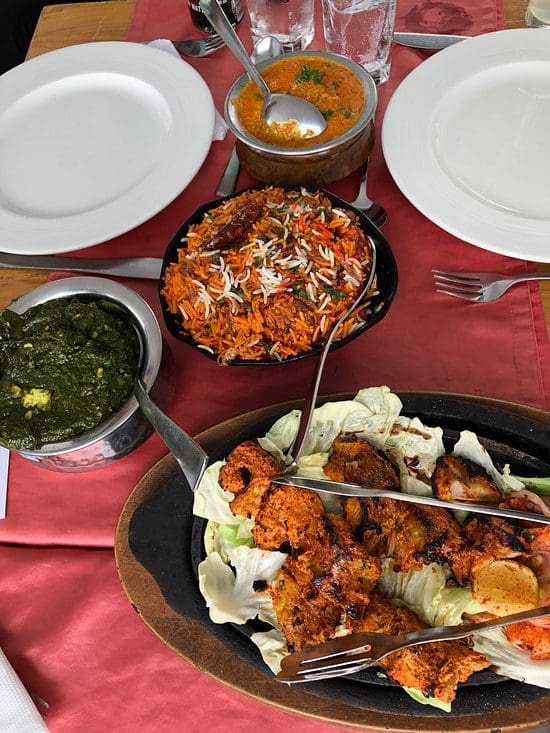



After our tour of the city it was time for lunch. Our companion dragged us quite a way from the city but it turned out to be well worth the trip. Khamma Ghani Restaurant was beautifully situated overlooking the water and also nestled in greenery which further added to the experience.
True to form, we were so absorbed by the whole experience that we forgot to take pictures. You can still see it as a positive that so far we prefer to enjoy the experience rather than photographing it.




In the evening of the same day, we had a little special surprise booked. A few days earlier we had asked for advice on where we could eat the best Indian food in town. The person we asked then offered to arrange a table for us, which turned out to be a stroke of luck as it was a popular place that was almost always fully booked.
The restaurant was in an old hotel which was an odd mix of British, Indian, new and old. In the courtyard was a cozy garden with small ponds, waterfalls and beautiful flowers. The restaurant itself was on the top floor and had a fantastic view of the City Palace and the old town.






The food was really good and the only thing we felt was missing was a good wine. It turned out that Republic Day is a so-called "dry day" which we did not know. When they said it the first time, we thought they were joking but we learned that on some major holidays it is forbidden to serve alcohol which is called "dry day". This legislation applies to all sales, so bars and shops are also covered by the ban.
Another thing that may be worth knowing is that in some states it is completely prohibited to sell alcohol, which has consequences on both sides of the border. On the side without the ban, the biggest consequence seems to be that the bars of the border towns are overflowing with visitors from the dry side of the border.




Another of our favorites was the Sunset Terrace which is part of the Taj Fateh Prakash Palace. In other words, it is the same chain that we visited on my birthday in Jaipur. You can read more about it here.
We were certainly close to starvation as we hadn't eaten anything for at least an hour, but even if we hadn't been in this critical condition, I'm absolutely convinced that we would still have appreciated the food. The environment felt luxurious but not excessive, the service was excellent and the food absolutely incomparably good. Add to that an excellent wine list which we certainly weren't spoiled for on this trip.



When we were googling places, we saw a name that stood out among the others, Charcoal by Carlsson. It turned out to be a guy from Örebro who started a charcoal grill in Udaipur of all places. I would love to hear more about how that decision-making process went.
When we visited the restaurant, Carlsson himself was not there, but his Indian companion became very enthusiastic when we told him that we came from Sweden and also from a town near Örebro. As you can see from the pictures, there is a fantastic view from the restaurant.





As for the food, it was really good. We ate charcoal-grilled pineapple and a particularly well-cooked souvlaki. The pineapple was unexpectedly spicy but still very good. We have tried to do this ourselves on the grill without quite succeeding but after this visit we really need to try again. In addition to the food, they also had good drinks and cake in a cup, which turned out to be a type of cake with either Nutella or chocolate filling. Very good!


They are very fond of sweets in this country. This was not least noticeable in the recurring processions of bakers who were often seen marching through the city with impressive pastries. They were often so large and complicated that eight to ten people were required to carry them.
Then we have this thing with shopping, which gives both positive and negative associations. It is really possible to buy everything in India and also at very good prices. At the same time, it is often very difficult to stroll around a store alone as the salespeople are EXTREMELY busy. We have to give them that, unlike countries with more of a bazaar culture, they don't use arguments to make you feel sorry for them or their family. It is rather that they try to create a connection by pulling some Swedish phrase, telling an anecdote from when they were in Sweden, how their goods are unique in all of India, etc.
It also feels like everyone has something to sell. Whether it's taxi drivers, restaurant staff, guides or just someone you ask for directions. Like for example. when a very well-dressed man braked his Vespa right in front of our feet and started telling us how he needed to practice his English as he had been invited to Sweden by some Swedish cultural foundation. Apparently they wanted to see his mother's unique embroidery. This conversation, like many others, ended in him wanting to sell us shawls.
They are generally very likeable and after all just doing their job, but it still gets a bit tiring when you have to listen to the same pitch ten times in a row.


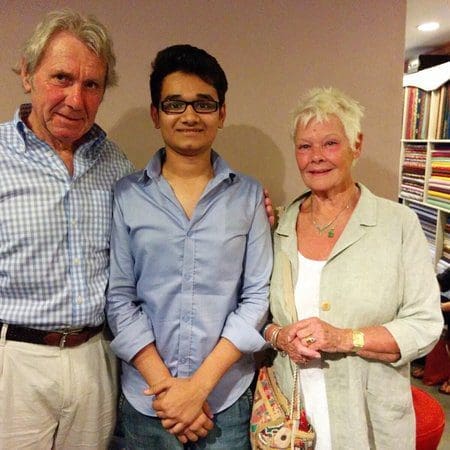


We made a lot of purchases on the trip that we are very happy with. Among other things, it turned out to be a carpet, some miniature paintings, jewellery, shawls, clothes and various small ornaments. Most of it could be sent by post, so you didn't have to lug the stuff around in your overstuffed suitcases.
Finally, however, I have to mention a tailor that we really appreciated. His name was Prateek and he owned a small tailoring shop called Sandouk, house of fashion. He had a completely different approach to the other shop owners we encountered as he was a little withdrawn and instead of talking us down, he used his knowledge and professionalism to impress us. I ended up buying two suits and some shirts from him.
When we were there the second time to take measurements, he told us that he had worked on Savile Row, how the actors from the Marigold Hotel had bought their clothes there and how he had been featured in Newsweek and GQ. At the time we felt "here we go again" which disappointed us a little but guess what, we were embarrassed when we googled it and it all turned out to be true. He really was an incredibly interesting person and skilled tailor who we can really recommend.
This was perhaps our most important lesson that we take with us from India. We have probably never been to a country where we received better treatment and despite this we were constantly on our guard. Everyone was incredibly helpful, friendly, curious and really gave no cause for suspicion whatsoever. So, our tip is to leave your Western skepticism at home and embrace what is new with open eyes.


